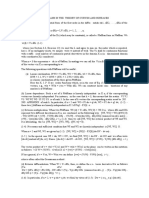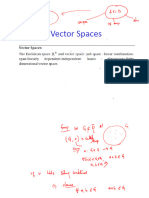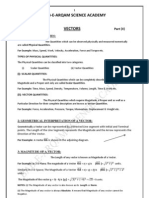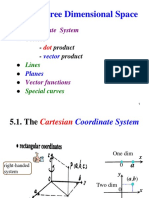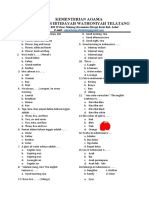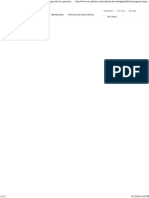Vector I 2015
Uploaded by
Purawin SubramaniamVector I 2015
Uploaded by
Purawin SubramaniamVectors and Vector Operations
Vectors and Vector Operations
1.1 Vector representation and operation
Def. : Geometric representation of a vector
A vector can be represented by an
arrow segment, in which the
magnitude of the vector is the length
of the segment and the direction of the
vector is that of the arrow. The vector
sum of two vectors A and B is
represented graphically as shown in the
figure.
A+B
Def. : Algebraic definition of vector in two dimensional plane
In two dimensional plane, a vector is
usually represented by its x- and ycomponents, i.e.
tan=(vy/vx)
y
v=(vx,vy).
v
vy
Thus the magnitude of the vector is
given by:
v vx vy
2
vx
and the angle between the x-axis is
given by:
Def. : Addition and scalar multiplication of vector
If u=(ux, uy), v=(vx, vy) and is a scalar then,
(i)
(ii)
u+v=(ux+vx, uy+vy)
u=(ux, uy)
(iii)
(iv)
u=(-ux, -uy)
u-v=u+(-v)=(ux-vx, uy-vy)
Def. : Zero vector and unit vector
- A zero vector 0 is a vector such that for any non-zero vector v, v+0=v.
- A unit vector is a vector such that its magnitude is one and is usually represented by
v .
Theorem 1 : Some algebraic properties of vector
If u, v and w are vectors, and are two scalars and 0 is the zero vector.
(i)
u+v=v+u
(vi)
(u+v)=u+v
(ii)
u+(v+w)=(u+v)+w
(vii) v=v
(iii) v+(-v)=0
(iv)
(v)=(v)
(v)
(+)v=v+v
Sk/EUM114/Vector 1 Lecture/2015
Vectors and Vector Operations
Writing vector in form of v x i v y j
Def. : Unit vector i and j
Unit vectors i and j are defined as the unit vector having the directions of x-axis and
y-axis respectively.
y
If we have any vector v=(vx, vy), we
notice that we can write it into
component form:
vxi
vyj
v = v x i v y j
x
i
Example If v=2 i -3 j is a vector, find the unit vector which has the same direction
as that of v.
1.2 Dot product
Def. Dot product of two vector u=ux i +uy j and v=vx i +vy j is a scalar and is defined
as:
uv=uxvx+uyvy
Example : If u=(1, 3) and v=(4, -7) then uv=14+3(-7)=-17.
Theorem 2 : Properties of Dot Product
For some vectors u, v and w,
(i)
uv=vu
(ii)
(u+v)w=uw+vw
(iii) (u)v=(uv), for some is
scalar
uu0 and uu=0 iff u=0
u2=uu
(iv)
(v)
Def. : Angle between two vectors
v
Let u and v be the angles between the
vectors v v x i v y j and
u u i u j with the x-axis
v-u
u
v u
respectively. Therefore,
x
and
vx=vcosv and ux=ucosu
vy=vsinv and uy=usinu.
Therefore, uv=uv(cosvcosu+sinusinv)=uv cos(v-u)= uv cos(u-v)
Or
uv=uv cos
where is the angle between u and v.
Sk/EUM114/Vector 1 Lecture/2015
(1)
Vectors and Vector Operations
Theorem 3 : If u and v are non-zero vectors, then
cos
uv
uv
(2)
where is the angle between the vectors u and v.
Example : Find the angle between the vectors 2i 3j and - 7i + j .
Solution : u=(2x2+3x3)1/2=131/2 , v=501/2, uv=2(-7)+3(1)=-11
uv
cos
0.431 115.6o
uv
Def. : Parallel and Anti-parallel vectors
Two vectors are said to be anti-parallel iff the angle between them is .
Two vectors are said to be parallel iff the angle between them is 0.
Note :
If v and u are parallel then u = tv for some positive scalar t.
If v and u are anti-parallel, then u = tv for some negative scalar t.
Def. : Orthogonal vectors
Two vectors are said to be orthogonal iff they are perpendicular.
Thus, if u and v are non-zero vectors, and they are orthogonal, then uv=0.
Example : Check if 3i 4j and 4i + 3j are orthogonal.
Solution : uv=3(4)+(-4)(3)=0
Def. : Projection and component
If u and v are non-zero vectors. Then the projection of u onto v is defined as:
uv v uv
(3)
Proj v u
v
v v
v
v
where v
is the unit vector pointing in the direction of v.
v
Geometric interpretation :
v
Projv
u
Proj v u
uv v
v u v u v u v cos
u cos
v v
v v
v
v
Sk/EUM114/Vector 1 Lecture/2015
Vectors and Vector Operations
Therefore, Projvu is a vector having a magnitude of the perpendicular projection of u
onto v and the same direction of v . Or sometimes we say the component of u in the
uv
direction of v is
.
v
Example : If u 2i 3j and v = i + j , find (i) Projvu and (ii) the component of u in
the direction of v.
v
1 1
Solution : The unit vector of v
i
j , v 2 and uv=2(1)+(-3)(1) =
v
2
2
u v
1 1 1 1 1
-1, therefore (i) Projvu
v =
(
i
j) i j and (ii) the
v
2
2
2 2
2
u v 1
component of u in the direction of v is
=
v
2
1.3 Vectors in three dimensional space
z
A vector v is defined in the three
dimensional space by its x-, y- and zcomponents
v
vz
v=(vx,vy,vz).
vy
vx
x
The magnitude of v is:
v vx 2 v y2 vz2
(4)
Notice that all the vector properties and operations in the two dimensional space are
also valid in the three dimensional case.
Examples :
(1) If u=(2, 3, 1) and v=(-6, 2, 4)
(i) u+v=(-4,5,5)
(ii) u-v=(8,1,-3)
(iii) uv=2x(-6)+3x2+1x4=-2
(2) Distance between two points in 3-D space
Find the separation between the points (1, 3, 1) and (1, 0, 4).
We can let u=(1, 3, 1) and v=(1, 0, 4). Consider d=u-v then the magnitude of d is the
distance between these two points
d=((1-1)2+(3-0)2+(1-4)2)1/2=18 1/2
(3) Find a unit vector that has the same direction as the vector v=(2, 4, -3).
v=((2)2+(4)2+(-3)2)1/2=29 1/2
Sk/EUM114/Vector 1 Lecture/2015
Vectors and Vector Operations
Unit vectors i, j and k
Similar to the two dimensional space, unit vectors parallel to the x-, y- and z-axis are
defined as:
i (1,0,0); j (0,1,0) and k (0,0,1)
and thus,
v (v x , v y , v z ) v x i v y j v z k
Direction cosine of a vector
z
(0 , 0, V)
z
(Vx, Vy , V)
z
y
(0 , Vy , 0)
(Vx, 0 , 0)
x
The angle , and are called the direction angles.
The direction cosines of the vectors are defined by:
cos
v
vx
v
, cos y , cos z
v
v
v
(5)
Notice that: cos2+cos2+cos2=1.
Example :
(1) Find the direction cosines of the vector v=(4, -1, 6).
The magnitude of the vector is v=((4)2+(-1)2+(6)2)1/2=531/2
4
1
6
cos
, cos
, cos
53
53
53
(2) Find a vector having magnitude equal to 7 and direction cosines equal to 1/(6)1/2,
1/(3)1/2 and 1/(2)1/2.
7
7
7
v x v cos
, v y v cos
, v z v cos
6
3
2
Cross Product
Def. : The cross product of two vectors:
u u x i u y j u z k and v v x i v y j v z k
Sk/EUM114/Vector 1 Lecture/2015
Vectors and Vector Operations
is defined as:
u v (u y v z u z v y )i (u z v x u x v z )j (u x v y u y v x )k
i
ux
uy
uz
vx
vy
vz
(6)
Example : Find the cross product of uv, if u=(2, 4, -5) and v=(-3, -2, 1).
u v 2
5 6i 13j 8k
3 2
Geometric interpretation of cross product
uv
v
u v u v sin
(7)
Some properties of cross product
(i) u0=0u=0
(ii) uv=-(vu)
(iii) (u)v=(uv)
(iv) u(v+w)=(uv)+(uw)
(v) (uv)w=u(vw)
(vi) u(uv)=v(uv)=0
(vii) if u and v are parallel, then
uv=0.
Note : (vi) tells us that:
The cross product uv is orthogonal to u and v.
Cross product of the unit vectors i, j and k
ii=0, jj=0, kk=0,
ij=k, ki=j, jk=i
1.4 Lines in three dimensional space
Straight line in two dimensional space-a review
slope-intercept form: y=mx+c
y y1 y 2 y
two point form: 2
x2 x1 x2 x
y y
m
point-slope form: 1
x1 x
General equation: ax+by+c=0
Sk/EUM114/Vector 1 Lecture/2015
Vectors and Vector Operations
Equation of a line
OP
PQ
OQ
O
PR
R(x,y,z)
If we have a line passing through two points with known co-ordinates P(x1, y1, z1)
and Q(x2, y2, z2), and we want to find the line equation in three dimensional space,
OP x1i y1 j z1k and OQ x2i y2 j z 2 k
Therefore, the vector segment pointing from P to Q is:
PQ PO OQ OQ OP (x 2 x1 )i (y 2 y1 )j (z 2 z1 )k
For any point R(x, y, z) on the line, PR is parallel to PQ, which implies that:
PR= t PQ ,
for some scalar t
Or,
(x x1 )i (y y1 )j (z z1 )k t (x 2 x1 )i t (y2 y1 )j t (z2 z1 )k 1
(8)
Vector equations for a line
x x1 t ( x2 x1 )
y y1 t ( y 2 y1 ) Parametric equations of a line
(9)
z z1 t ( z 2 z1 )
Or we can rearrange the parametric equation by eliminating the parameter t to get:
x x1
y y1
z z1
Symmetric equations
x2 x1 y 2 y1 z 2 z1
(10)
Examples :
(i) Find the vector equations, parametric equations and the symmetric equations for
the line passing through the points P=(2, -1, 6) and Q=(3, 1, -2).
Solution :
(a) (x 2)i (y+1)j (z-6)k t (1)i t (2)j t (-8)k 1
x 2 t (1)
(b) y 1 t (2)
z 6 t (8)
Sk/EUM114/Vector 1 Lecture/2015
Vectors and Vector Operations
(c)
x 2 y 1 z 6
1
2
8
(ii) Find the parametric equation and the symmetric equation for the line L passing
through (1, -2, 4) and parallel to v=i+j-k
Solution : Since this line passes through (1, -2, 4) so L=(x-1)i+(y+2)j+(z-4)k
And it also parallel to v=i+j-k so L=ti+tj-tk
x 1 t
The parametric eq. is y 2 t
z 4t
x 1 y 2 z 4
And the symmetric eq. is
1
1
1
1.5 Plane equation in 3D space
z
N
Q (X , Y , Z)
Consider a plane has a normal vector of
N=ai+bj+ck, i.e., N is perpendicular to
the plane, and a point P(xo, yo, zo) is
lying on the plane.
For any point Q(x, y, z) on the plane, N
must be perpendicular to the vector
PQ=(x-xo)i +(y-yo)j +(z-zo)k.
Therefore, NPQ=0 implies a(xy xo)+b(y-yo)+c(z-zo)=0
PQ
o
P (Xo , Yo , Zo)
ax+by+cz=axo+byo+czo=d
(11)
Equation of plane
Examples:
(i) Find an equation of the plane passing through the point (2, 5, 1) and normal to the
vector N=i-2j+3k.
Solution : x-2y+3z=1x2-2x5+3x1=-5
(ii) Find an equation of the plane passing through the points P=(1, 2, 1), Q=(-2, 3, -1)
and R=(1, 0, 4).
Solution :
(a)The general form of eq. of plane is ax+by+cz=d. First this plane contains all these
three points, we have
a+2b+c=d, -2a+3b-c=d and a+4c=d
(b)We need one more equation. However, we can N as a unit vector, which means
a2+b2+c2=1
By solving these four equations we obtain a= -1/1181/2, b=9/1181/2, c=6/1181/2 and
d=23/1181/2. Remarks: (1) the common factor 1/1181/2 can be deleted. (2)There are
two set of solution due to the fact that a2+b2+c2=1 has two roots, +/- sign.
Sk/EUM114/Vector 1 Lecture/2015
Vectors and Vector Operations
(iii) Find all the points of intersection of the planes 2x-y-z=3 and x+2y+3z=7.
Solution : Two planes will intersect and form a line. We can obtain the eq. of the line
by the following steps:
(a)We can find the direction of the line. The normal unit vectors for these two planes
are n1=(2,-1,-1) and n2=(1,2,3). Note : both n1 and n2 must be perpendicular to the
line, therefore
(b) nL=n1 x n2 = (-1,-7,5) is a unit vector in the direction along the line, then L=t nL=
(-t,-7t,5t) = t (x 2 x1 )i t (y2 y1 )j t (z 2 z1 )k 1
(c)Let x=0, this line will go through the point by solving y-z=3 and 2y+3z=7, which
gives the point P=(x1, y1, z1) =(0,-16, 13) passed by the line.
We obtain the line equation as
x y 16 z 13
1
7
5
x2
a
y2
b
z2
where a and b are the diameter on the x and y axis direction respectively.
Appendix Triple products
Dot and cross multiplication of three vectors A, B and C may produce
meaningful products of the form A ( B C ) and A ( B C ) . The following laws
are valid:(A.1)
A ( B C ) B (C A) C ( A B)
The common product is the volume of a parallelepiped having A , B and C as edges,
or the negative of this volume according as A, B and C do or do not form a righthanded system.
If A a1 i a2 j a 3 k , B b1 i b2 j b 3 k and C c1 i c2 j c3 k then
a1 a 2 a 3
A B C b1
b2
b3
c1
c2
c3
(A.2)
Definition A.1
Sk/EUM114/Vector 1 Lecture/2015
Vectors and Vector Operations
The commutation of products A ( B C ) is known as the scalar triple product
of A, B and C. The scalar triple product of A, B and C is usually written simply as
[A,B,C] and, because of the appearance of this notation, is often called their box
product.
( A B) C A ( B C )
A B C B C A C A B
(A.3)
A C B B A C C B A
Note
The absolute value of the scalar triple product A ( B C ) of the three
noncoplanar vectors is the volume of the parallelepiped having A, B and C as
concurrent edges.
Definition A2
The product A ( B C ) is called the vector triple product. It should be noted
that A ( B C ) and ( A B) C denote different vectors
A ( B C ) ( A B) C .
If A a1 i a2 j a 3 k , B b1 i b2 j b 3 k and C c1 i c2 j c3 k then
i
j
k
(A.4)
A (B C)
a1
a2
a3
b2 c3 b3c2
b3c1 b1c3 b1c2 b2 c1
we can get the formula:
A ( B C ) ( A C ) B ( A B)C
( A B) C ( A C ) B ( B C ) A
Proof of Eq.(A.5)
(A.5)
(A.6)
The x-component of A ( B C ) is
a 2 b1c2 b2 c1 a 3 b3 c1 b1c3 a 2 b1c2 a 2 b2 c1 a 3b3 c1 a 3b1c3
a 2 c2 b1 a 3 c3b1 a 2 b2 c1 a 3b3 c1
a1c1b1 a 2 c2 b1 a 3 c3b1 a1b1c1 a 2 b2 c1 a 3b3 c1
a1c1 a 2 c2 a 3 c3 b1 a1b1 a 2 b2 a 3b3 c1
A C b1 A B c1
The R.H.S. of the above expression is just the x-component of ( A C ) B ( A B)C .
Similarly proof can be applied for the y-component and z-component.
Example 1
Given the three vectors,
A 3i 2 j 2k
B 6i 4 j 2k
C 3i 2 j 4k
Compute the values A ( B C ) and A ( B C )
Sk/EUM114/Vector 1 Lecture/2015
10
Vectors and Vector Operations
Solution 1
3
A B C 6
2
4
2
2 120
3 2 4
By Eq.(A.5), we have
A ( B C ) ( A C ) B ( A B)C
= 13B 6C 13(6i 4 j 2 k ) 6( 3i 2 j 4 k )
= 80i 34 j 2 k
Example.2
Show that
(a)
( A B) (C D) ( A C ) ( B D) ( A D) ( B C )
(b)
A ( B C ) B (C A) C ( A B) 0
Solution 2
(a)
By the property Eq.(9.11) of scalar triple product, we have
( A B) (C D) A B (C D) A ( B D)C ( B C ) D
= A ( B D)C A ( B C ) D ( A C )( B D) ( A D)( B C )
(b)
By Eq.(A.5), we have
A ( B C ) ( A C ) B ( A B)C
B (C A) ( B A)C ( B C ) A
C ( A B) (C B) A (C A) B
Adding the above equalities and the result follows.
Sk/EUM114/Vector 1 Lecture/2015
11
You might also like
- MTHFR Protocol - Personalization by Chris Masterjohn100% (10)MTHFR Protocol - Personalization by Chris Masterjohn92 pages
- Automatic Street Light Control System Using IOTppt90% (10)Automatic Street Light Control System Using IOTppt21 pages
- Chapter 3. Vector in 2-Space and 3-SpaceNo ratings yetChapter 3. Vector in 2-Space and 3-Space45 pages
- 12.4 The Cross Product / Vector: R S R S RsNo ratings yet12.4 The Cross Product / Vector: R S R S Rs6 pages
- 10.2 Vectors in Space: Coordinate Frame. WhenNo ratings yet10.2 Vectors in Space: Coordinate Frame. When11 pages
- DPP X X y y Z Z: The Vectors and ApplicationsNo ratings yetDPP X X y y Z Z: The Vectors and Applications10 pages
- Chapter 3 Vectors in 2-Space and 3-SpaceNo ratings yetChapter 3 Vectors in 2-Space and 3-Space68 pages
- Multivariable Calculus Math 21a: Harvard University Spring 2004 Oliver KnillNo ratings yetMultivariable Calculus Math 21a: Harvard University Spring 2004 Oliver Knill64 pages
- Elementary Vector Analysis: Harvey Mudd College Math TutorialNo ratings yetElementary Vector Analysis: Harvey Mudd College Math Tutorial5 pages
- Vector Algebra: MATH23 Multivariable CalculusNo ratings yetVector Algebra: MATH23 Multivariable Calculus18 pages
- Real Vector Spaces: Vectors in The Plane and in 3-SpaceNo ratings yetReal Vector Spaces: Vectors in The Plane and in 3-Space9 pages
- Section 3: Cross Product of Vectors: Vector AlgebraNo ratings yetSection 3: Cross Product of Vectors: Vector Algebra6 pages
- Three Dimensional Space: Coordinate SystemNo ratings yetThree Dimensional Space: Coordinate System82 pages
- Student's Solutions Manual and Supplementary Materials for Econometric Analysis of Cross Section and Panel Data, second editionFrom EverandStudent's Solutions Manual and Supplementary Materials for Econometric Analysis of Cross Section and Panel Data, second editionNo ratings yet
- Structural Dynamics - ESA 322 Lecture 3aNo ratings yetStructural Dynamics - ESA 322 Lecture 3a34 pages
- Your Final Expenses Your Family Emergency FundsNo ratings yetYour Final Expenses Your Family Emergency Funds1 page
- Proposal Work Industrial Visit To Spirit Aerosystems Malaysia SDN BHD Organized byNo ratings yetProposal Work Industrial Visit To Spirit Aerosystems Malaysia SDN BHD Organized by8 pages
- Reflective Journal ESA366 Purawin Subramaniam 125211No ratings yetReflective Journal ESA366 Purawin Subramaniam 1252112 pages
- Title Experiment 8: Electrical Circuit A. Measure Voltage, Current, Power & Resistance in The Direct Current (DC) CircuitNo ratings yetTitle Experiment 8: Electrical Circuit A. Measure Voltage, Current, Power & Resistance in The Direct Current (DC) Circuit24 pages
- Ahmad Shaqeer Bin Mohd. Thaheer: Keywords: Aerospace, Astrophysics, Physics, String Theory, AircraftNo ratings yetAhmad Shaqeer Bin Mohd. Thaheer: Keywords: Aerospace, Astrophysics, Physics, String Theory, Aircraft2 pages
- EML 222/2 Engineering Lab Ii: Experiment Report100% (1)EML 222/2 Engineering Lab Ii: Experiment Report14 pages
- East Africa University Bosaso, Puntland Somalia Faculty of Medicine Communicable Disease MR Buruj Ali SaladNo ratings yetEast Africa University Bosaso, Puntland Somalia Faculty of Medicine Communicable Disease MR Buruj Ali Salad42 pages
- Mark Hyman - The Young Forever Cookbook (2024) - Libgen - LiNo ratings yetMark Hyman - The Young Forever Cookbook (2024) - Libgen - Li332 pages
- BS en 13230-4-2016+a1-2020 - (2023-05-31 - 08-27-28 PM)No ratings yetBS en 13230-4-2016+a1-2020 - (2023-05-31 - 08-27-28 PM)24 pages
- Method Statement For Fire Alarm System Installation100% (1)Method Statement For Fire Alarm System Installation4 pages
- Comparison of The ASME, BS and CEN Fatigue Design Rules For Pressure Vessels (October 2003)No ratings yetComparison of The ASME, BS and CEN Fatigue Design Rules For Pressure Vessels (October 2003)2 pages
- Potato Powered Lamp As An Alternative Light Source100% (4)Potato Powered Lamp As An Alternative Light Source8 pages
- Zero and 1st Conditionals Grammar ExercisesNo ratings yetZero and 1st Conditionals Grammar Exercises2 pages
- Termasuk: Ring Blower Ex - Resun/ Setara, Cap. 0,14m3/ Min, Power 0,1 kW/220V/1Ph/50hz100% (1)Termasuk: Ring Blower Ex - Resun/ Setara, Cap. 0,14m3/ Min, Power 0,1 kW/220V/1Ph/50hz2 pages
- 2024_02_20_LIM LFSC Practical Task 1 Grade 12 QP ENG FinalNo ratings yet2024_02_20_LIM LFSC Practical Task 1 Grade 12 QP ENG Final6 pages
- Stephanie Paladino (Editor), Shirley J Fiske (Editor) - The Carbon Fix - Forest Carbon, Social Justice, and Environmental Governance-Routledge (2016)No ratings yetStephanie Paladino (Editor), Shirley J Fiske (Editor) - The Carbon Fix - Forest Carbon, Social Justice, and Environmental Governance-Routledge (2016)356 pages
- Arch - Part01 - Lot 1-2 - 31 Herrick ST, MT Gravatt - Rev A2 - BR20230304No ratings yetArch - Part01 - Lot 1-2 - 31 Herrick ST, MT Gravatt - Rev A2 - BR202303048 pages
- MDCT: Technical Principles and Future Trends: Mathias ProkopNo ratings yetMDCT: Technical Principles and Future Trends: Mathias Prokop8 pages
- MTHFR Protocol - Personalization by Chris MasterjohnMTHFR Protocol - Personalization by Chris Masterjohn
- Automatic Street Light Control System Using IOTpptAutomatic Street Light Control System Using IOTppt
- Multivariable Calculus Math 21a: Harvard University Spring 2004 Oliver KnillMultivariable Calculus Math 21a: Harvard University Spring 2004 Oliver Knill
- Elementary Vector Analysis: Harvey Mudd College Math TutorialElementary Vector Analysis: Harvey Mudd College Math Tutorial
- Real Vector Spaces: Vectors in The Plane and in 3-SpaceReal Vector Spaces: Vectors in The Plane and in 3-Space
- Section 3: Cross Product of Vectors: Vector AlgebraSection 3: Cross Product of Vectors: Vector Algebra
- Student's Solutions Manual and Supplementary Materials for Econometric Analysis of Cross Section and Panel Data, second editionFrom EverandStudent's Solutions Manual and Supplementary Materials for Econometric Analysis of Cross Section and Panel Data, second edition
- Transformation of Axes (Geometry) Mathematics Question BankFrom EverandTransformation of Axes (Geometry) Mathematics Question Bank
- Proposal Work Industrial Visit To Spirit Aerosystems Malaysia SDN BHD Organized byProposal Work Industrial Visit To Spirit Aerosystems Malaysia SDN BHD Organized by
- Reflective Journal ESA366 Purawin Subramaniam 125211Reflective Journal ESA366 Purawin Subramaniam 125211
- Title Experiment 8: Electrical Circuit A. Measure Voltage, Current, Power & Resistance in The Direct Current (DC) CircuitTitle Experiment 8: Electrical Circuit A. Measure Voltage, Current, Power & Resistance in The Direct Current (DC) Circuit
- Ahmad Shaqeer Bin Mohd. Thaheer: Keywords: Aerospace, Astrophysics, Physics, String Theory, AircraftAhmad Shaqeer Bin Mohd. Thaheer: Keywords: Aerospace, Astrophysics, Physics, String Theory, Aircraft
- East Africa University Bosaso, Puntland Somalia Faculty of Medicine Communicable Disease MR Buruj Ali SaladEast Africa University Bosaso, Puntland Somalia Faculty of Medicine Communicable Disease MR Buruj Ali Salad
- Mark Hyman - The Young Forever Cookbook (2024) - Libgen - LiMark Hyman - The Young Forever Cookbook (2024) - Libgen - Li
- BS en 13230-4-2016+a1-2020 - (2023-05-31 - 08-27-28 PM)BS en 13230-4-2016+a1-2020 - (2023-05-31 - 08-27-28 PM)
- Method Statement For Fire Alarm System InstallationMethod Statement For Fire Alarm System Installation
- Comparison of The ASME, BS and CEN Fatigue Design Rules For Pressure Vessels (October 2003)Comparison of The ASME, BS and CEN Fatigue Design Rules For Pressure Vessels (October 2003)
- Potato Powered Lamp As An Alternative Light SourcePotato Powered Lamp As An Alternative Light Source
- Termasuk: Ring Blower Ex - Resun/ Setara, Cap. 0,14m3/ Min, Power 0,1 kW/220V/1Ph/50hzTermasuk: Ring Blower Ex - Resun/ Setara, Cap. 0,14m3/ Min, Power 0,1 kW/220V/1Ph/50hz
- 2024_02_20_LIM LFSC Practical Task 1 Grade 12 QP ENG Final2024_02_20_LIM LFSC Practical Task 1 Grade 12 QP ENG Final
- Stephanie Paladino (Editor), Shirley J Fiske (Editor) - The Carbon Fix - Forest Carbon, Social Justice, and Environmental Governance-Routledge (2016)Stephanie Paladino (Editor), Shirley J Fiske (Editor) - The Carbon Fix - Forest Carbon, Social Justice, and Environmental Governance-Routledge (2016)
- Arch - Part01 - Lot 1-2 - 31 Herrick ST, MT Gravatt - Rev A2 - BR20230304Arch - Part01 - Lot 1-2 - 31 Herrick ST, MT Gravatt - Rev A2 - BR20230304
- MDCT: Technical Principles and Future Trends: Mathias ProkopMDCT: Technical Principles and Future Trends: Mathias Prokop



































